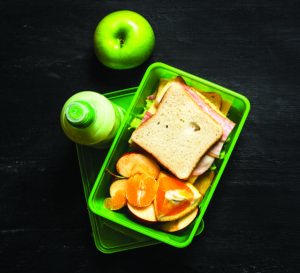Truly Deeply Madly
No-Litter Lunches
March, 2017
We’ve become accustomed to a certain level of convenience when it comes to packing our lunches. But the easiest option isn’t always the best one. Our lunches, and those we pack for our kids, produce a lot of waste that’s hard on the environment. Luckily, it’s easier than ever to plan and pack a low-litter lunch that’s not only eco-friendly but also budget-friendly and healthy. Here are some tips for cleaning up your lunchtime habits.

Reusable Containers
Replacing your paper or plastic lunch bag with a reusable alternative is always a good place to start when reducing your lunchtime waste. But it’s only the start. The foils and plastics we use to hold our sandwiches and mid-day snacks also have their litter-free versions. Tupperware is an obvious choice, but if you find those containers too clunky, you might want to try cloth sandwich bags. They’re easy to clean and zip up tight so that your sandwich and vegetables won’t combine into a mixed salad on the way to school or work.
Avoid Individually Packaged Food
It’s easy to grab a granola bar or a package of cookies on your way out of the house, but these individually packaged portions are some of the largest contributors to lunchtime waste. Of course, most snack foods like granola bars don’t come packaged any other way, so this is where the bulk aisle can be your friend. Try buying snacks such as loose granola or mixed nuts. If your favourite snacks don’t come in bulk, you can still reduce waste by buying the “family sized” version and portioning it out into single servings that you pack in reusable containers.
Plan Lunches in Advance
With a little planning, packing your no-litter lunches won’t turn into a time-consuming ordeal. In fact, the 20 minutes you spend on Sunday night thinking about what your week’s lunches are going to be can buy you 10 minutes every morning. Do you have a lot of leftovers in the fridge? If you’ve got the containers to spare, you can begin portioning out these meals a few days in advance. You can also fill your reusable bags with dry snacks and stock your fridge with fruit and vegetables that are ready to go. Just like that, you can have all of your lunches planned before your week even begins. You’ll likely find that you’re making healthier choices, too.
Invest in a Drink Container
Reusable water bottles and coffee mugs are always a smart investment. Not only will they save you money and time in the drive-through every morning, they’ll also reduce the amount of waste you generate and can be filled with virtually any drink you want.
Learn where the water fountains are at your school or place of work, and take advantage of them. If you swear by your favourite coffee shop’s signature brew, bring your mug to them and ask them to fill it instead. Most businesses will be happy to oblige.
Know Your Eating Habits
One big danger when it comes to packing lunches is the tendency to either over pack or under pack. By packing too much, you risk wasting the food. Even though it may be biodegradable, food waste is still considered waste, both in terms of money and the environment. In terms of the environment, when organic material decomposes outside of the presence of oxygen (as is the case in most municipal landfills) it produces methane, a harmful greenhouse gas.
When you under pack your lunches, you might find yourself visiting the nearest vending machine or fast-food location throughout the day, spending more money and creating more waste than you intended. So take some time to learn your eating habits, and you’ll be packing the right proportion in no time. t8n
Fun Fact
Disposable plastic containers don’t seem expensive when you look at them individually, but these small prices add up. Over the course of a year, Canadian families spend roughly $450 on disposable lunch packaging.
Did You Know?
A study done by an Okanagan school board found that the average school child produces
67 pounds of lunch-related waste per year. If you multiply that by the estimated 5 million school-aged children in Canada… well, that’s a whole lot of waste.













